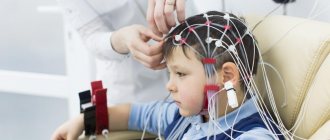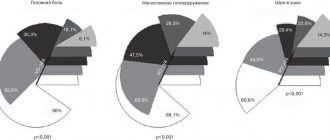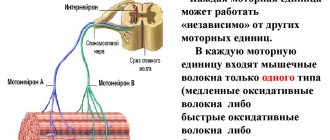In children, speech skills develop gradually until approximately 4 years of age. Some errors in speech are present in children of older preschool age. Over time, with proper communication between the people around them, mistakes in conversation and perception of texts in children disappear.
If a mature person does not understand the written text, can name only a few main words from the information read, does not express his thoughts well, and his speech lacks verbs, prepositions, and conjunctions, he should consult a doctor.
Perhaps the combination of these signs is an expression of a disease called agrammatism. There are several types of deviation. Correct diagnosis can only be made by a qualified doctor after a comprehensive examination.
What underlies the development of the disorder?
A person’s ability to comprehend and reproduce speech depends on a large number of factors:
- age;
- level of general development;
- education;
- communication environment;
- communication skills;
- psychological status;
- physical condition.
The onset of the disease can be triggered by anatomical features, organic changes in local areas of the brain, for example, the Sylvian fissure, the frontal or temporal cortex of the dominant hemisphere.
Normal pronunciation of words and syntactic structures is possible with the impeccable functioning of all nerve cells in the brain.
Total agrammatism in children can also cause impaired hearing during the development of speech. If sound waves are poorly perceived by auditory analyzers, the child hears poorly, and it is difficult, even impossible, for him to formulate sentences correctly.
Speech skills can only be developed through repeated full listening to verbal expressions and immersion in the audio environment of the language.
Emerging speech disorders in adults who already have developed sentence pronunciation skills cannot be explained by changes in the functioning of auditory analyzers. In such situations, there is a high probability of neurological disorders.
Agrammatism is characteristic of the conditions of alalia, aphasia, speech of people without hearing or with poor hearing, and children with developmental delays.
Symptoms of agrammatism
Symptoms of this phenomenon begin to appear at an early age, when the child develops phrasal speech. This can be noticed quite easily - the child cannot construct sentences in the correct grammatical form.
As for the general speech defect, children with agrammatism begin to speak at all very late. And since babies, by definition, are still just learning to talk, parents notice late that something wrong is happening with the child’s speech.
At the same time, the sounds are pronounced correctly, so rarely does anyone worry about the emerging symptoms of agrammatism. After all, adults often sometimes violate the grammatical structure of sentences in their speech.
Only at school age do suspicions about a speech disorder begin to arise, when the teacher sees that the child is unable to learn case forms of words, he cannot coordinate words in a sentence. Ungrammaticality in writing is even easier to notice. Phrases such as “long strip”, “in front of the window” immediately catch the eye.
Usually, at the age of 7-8 years, a child can already freely coordinate words in speech. And such deviations are alarming.
Related posts:
- What is "War and Peace" about? Summary of the novel “War and Peace” by chapters. All answers...
- General underdevelopment of speech in children - GSD It is believed that children with general underdevelopment of speech (GSD) have incorrigible...
- Features of speech therapy work with a group of children with ODD Speech therapy work with children with ODD - methodological recommendations for...
- Degrees of severity of GSD - levels of underdevelopment Children with different levels of general speech underdevelopment (GSD) have characteristic...
Manifestations of agrammatism
Examples of agrammatisms
It is easier for a person with this disease to understand unambiguous sentences. For example, the phrase “I bought bread” will be understood more easily than the sentence “I am listening to you.” In the second case, unlike the first, the reverse action option “Are you listening to me” is possible.
Short phrases with the classic word order “It’s raining outside” are easier to understand, as opposed to a larger sentence with clarifications “It’s raining incessantly outside again.”
A sick person does not communicate quite competently from a literary point of view. Everyday speech structures differ significantly from correctly constructed sentences. The ability to perceive ordinary speech in people with agrammatism is significantly reduced.
Symptoms can be identified by a specialist through attentive communication, demonstration of visual materials, accompanied by a request to describe them, talk about them. If a person is sick, his speech consists of the simplest sentences, with a minimum of words, often pronounced slowly.
Briefly about agrammatism
There may also be errors in determining tense, number and gender, as well as difficulties in creating sentences with movement of grammatical elements such as passive sentences, interrogative constructions and complex sentences.
Spoken and written language typically show similar error patterns. Typically, individuals with agrammatic aphasia also demonstrate impaired comprehension of grammatical structures, particularly non-canonical semantically invertible sentences.
In a broad sense, agrammatism is a pathological inability to use words in grammatical sequence. Agrammatism is associated with Broca's aphasia, and there are many theories as to its cause. Adjective: ungrammatical.
According to Anna Basso and Robert Cubelli, "the most obvious characteristic of agrammatism is the omission of function words and affixes, at least in those languages that allow it; simplification of grammatical structures and disproportionate difficulty in extracting verbs are also common."
At present, says Mary-Louise Kean, “there are no closed questions or solved problems in the linguistic and psycholinguistic analysis of agrammatism.
Agrammatism is a disorder that results in difficulty with sentences. These difficulties can be associated with both correct understanding and correct sentence composition. That these difficulties arise at the sentence level is evident from the fact that the comprehension and production of words can be relatively spared.
Forms of violation
Experts distinguish two main forms of agrammatism:
- Impressive is characterized by a lack of understanding of speech in whole or in part. The root adjective in the title means “perception” in English. Changes in the functioning of brain cells do not allow the sound signal to transform into thoughts and images.
- Expressive disorders are identified when it is impossible to use prepositions, declensions, and cases in speech; when spoken sentences are formed incorrectly or incompletely. The root of the adjective in this title means "expression" in English. Problems with the functioning of the local area of the brain prevent the transformation of thoughts into speech phrases. Depending on the location of the problem area, the resulting speech anomaly (aphasia) may be sensory or motor in nature.
Sensory changes are caused by a violation of the ability to feel and perceive a sound signal.
Motor disorders in Broca's center cause difficulties in controlling the muscles of the larynx, tongue, and jaws, which do not allow speech to be reproduced well. Often the patient can only pronounce basic words.
His speech resembles the text of a telegraph message, in which nouns predominate or, conversely, only verbs are present. Such specific features make it possible to clarify the localization of the brain area with impaired activity.
What is agrammatism?
Every person learns speech thanks to the environment in which he finds himself. This usually takes up to 4 years of a person’s life. There are errors in understanding and constructing sentences, which is normal. In subsequent years, the child only adjusts his speech and chooses his own style of communication. However, no significant errors are observed. What is agrammatism? This is a speech disorder that manifests itself in the lack of the correct ability to form and perceive sentences.
Agrammatism can be recognized by the following signs:
- The person does not understand what is written.
- He is not able to retell what he read; he only singles out individual words.
- The person expresses his thoughts poorly.
- An individual’s speech lacks certain parts: prepositions, conjunctions, verbs.
In this case, you need to consult a doctor. Only he is able to identify the causes of speech impairment. It may not be agrammatism, in which case an accurate diagnosis is made and treatment is prescribed.
In people with this pathology, damage is observed in the Sylvian part of the brain. Agrammatism is used in relation to writing or reading. In adults, aphasia can be observed - the use in speech of words that are consonant in pronunciation, but not suitable in meaning.
go to top
Establishing diagnosis
Correct diagnosis is the result of comprehensive observation and examination. It is very important to determine:
- general condition of a person,
- his psychological and neurological status.
During communication, the specialist evaluates:
- rate of speech;
- variety of syntactic forms used;
- correct use of cases and declensions in speech;
- the presence of unions;
- the presence of prepositions in dialogue and monologue when describing a visual object.
When testing, the number of words and syllables in spoken sentences and the consistency of the endings used are assessed.
To identify disorders of brain activity, it is recommended to do an encephalogram, ultrasound or tomography.
Summarizing and analyzing the information received, the specialist makes a decision to establish a diagnosis.
Types of agrammatisms
Neuropathologists, neurologists, and reflexotherapists distinguish two main types of agrammatisms. These are impressive agrammatism and expressive agrammatism speech disorders.
Impressive agrammatism is marked by a complete or partial impairment of understanding the meaning of grammatical structures of perceived speech.
Expressive agrammatism is a grammatical violation of the design of active speech. Expressive agrammatism is characterized by the incorrect use of cases, prepositions, and declensions.
Treatment methods
Agrammatism is a neurological disorder that requires the help of qualified specialized doctors. Medical treatment, depending on the age and severity of the patient’s condition, may include a course of medication, reflexology, physiotherapeutic procedures, and hypnosis.
Correcting the condition with medications can significantly improve the blood circulation of brain cells and make them function more efficiently.
Impact on active points during reflexology can be carried out using different methods:
- mechanically;
- thermally;
- electrical discharge;
- laser beams;
- electromagnetic waves;
- pharmaceuticals;
- implantation of foreign elements;
- combining techniques.
Author's techniques, tested by many years of experience? differ in the choice of sensitive points on the patient’s body and methods of acting on them.
Positive changes are observed during physiotherapy for expressive agrammatism. For sensory problems, the correct choice of physiotherapeutic methods helps to improve the patient’s perception of sounds.
The influence of motor anomalies is minimized by restoring the activity of the muscles of the larynx, jaw, and tongue.
Agrammatism, like other neuropsychological disorders, can be corrected by professional hypnosis, which improves the quality of spoken speech.
The treatment algorithm is selected by specialists individually. In addition to medical care, the patient will need the help of psychologists, speech therapists, and teachers during the recovery period.
Examples of agrammatism in schoolchildren
Contrary to the rules of grammar, the child writes ungrammatically, for example, “on the table”, or “long road”. In accordance with age-related skills, children by the age of four should already be able to coordinate words correctly. It should be noted that at this age such speech errors cannot be considered the norm. When a child makes mistakes, such as “trees” or “near there”, then, of course, mandatory consultation with specialists is required. If we talk about the rules of word formation, where prefixes and suffixes are used, then children master such skills later, by about the age of eight. At this time, the student should already be able to normally coordinate words with each other, and easily form new ones. If this does not happen, then the specialist diagnoses agrammatism in children.
Upon admission to an educational institution, existing agrammatisms in school-age children are immediately identified. At the same time, a number of pronunciation defects are noted, the lexical and grammatical structure is unformed, and coherent speech and phonetic perception also do not correspond. A more pronounced manifestation of agrammatism is observed in seven- and eight-year-old children, because at this time schoolchildren are already mastering literacy and learning the rules of grammar. Prerequisites can be considered that the child has a poor vocabulary. According to research, this violation occurs precisely because of the poverty of the vocabulary, and incorrect understanding of the lexical meaning is also affected.
Sources
- https://neurofob.com/mental-behavioural/speech-disorders/agrammatizmy-v-rechi-eto.html
- https://sarclinic.ru/osnovnye-napravleniya/90-detskie-zabolevaniya/263-agrammatizm-paragrammatizm-disgrammatizm
- https://NeuroDoc.ru/bolezni/narusheniya-rechi/agrammatizmy.html
- https://www.psyportal.net/15691/agrammatizm/
[collapse]
You can anticipate trouble
To prevent the appearance of agrammatism, the normal neonatal period of the child’s formation is very important.
Neurological disorders of the unborn child can develop during a difficult pregnancy, aggravated by infectious or other diseases. A correct lifestyle and regular observation by an attentive doctor of the expectant mother is the key to the birth of a healthy baby.
Abnormalities in the functioning of brain cells can appear in adults due to past illnesses and circulatory disorders. A preventive measure is a careful attitude to one’s own state of health, the use of general strengthening procedures in everyday practice, and the formation of healthy lifestyle habits.
The condition of patients with agrammatism can be significantly improved, up to complete recovery. Successful treatment is possible with timely consultation with specialists and strict adherence to the doctor’s recommendations.
How to treat agrammatism, how to cure agrammatism, how to get rid of agrammatism in Sarklinik?
Sarklinik knows how to treat agrammatism , how to restore the grammatical structure of speech, how to get rid of agrammatism in Saratov. New reflexology treatment methods have helped many of our patients get rid of agrammatism. Effective treatment gives excellent results; patients (children and adults) restore the ability to use the grammatical structure of speech. On our website sarclinic.ru you can see a doctor for free and get a short answer on the treatment of agrammatism.
Sign up for a consultation. There are contraindications. Specialist consultation is required.
Photo: Bds | Dreamstime.com\Dreamstock.ru. The people depicted in the photo are models, do not suffer from the diseases described and/or all similarities are excluded.
Related posts:
Cerebral palsy in children, children with cerebral palsy, treatment
Tourette, Tourette syndrome, Tourette's disease, treatment Gilles de la Tourette
Depression in adolescents, children, treatment of depression in Saratov
How to treat bedwetting in children, treatment in Saratov, Russia
Dyslexia, treatment of dyslexia, correction, overcoming, elimination, alexia, treatment of alexia
Comments ()
Article:
The article reveals modern ideas about the mechanisms and manifestations of agrammatic dysgraphia in primary school students. The prerequisites that ensure the formation of grammatical generalizations are highlighted. The relationship is shown between the level of formation of grammatical generalizations and the prerequisites that ensure their formation in students with mental retardation, taking into account the neuropsychological approach. In modern speech therapy, manifestations of agrammatism in the oral and written speech of primary school students are considered in the structure of agrammatic dysgraphia. The mechanism of agrammatic dysgraphia is associated with underdevelopment of the morphological system of the language, unclear ideas about syntactic connections within a sentence and connections between sentences in the text (R.I. Lalaeva, R.E. Levina, S.B. Yakovlev, etc.). The main symptoms of agrammatic dysgraphia are grammatical errors in writing [5; 6; 12]. The most detailed analysis of grammatical errors in writing was carried out by S.B. Yakovlev. The author has identified three main types of agrammatisms: agrammatisms at the level of a connected text, agrammatisms at the sentence level (syntactic), morphological agrammatisms [12]. The designated types of writing agrammatisms are identified taking into account the psycholinguistic understanding of the process of generating written speech utterances (T.V. Akhutina, L.S. Vygotsky, A.A. Leontiev, A.R. Luria) and are associated with the immaturity of the stages of internal programming and grammatical structuring of speech statements [3; 4; 7; 8]. Research by S.V. Zorina, R.I. Lalaeva, N.V. Serebryakova et al. identified in children with mental retardation (MDD) violations of the syntactic design of statements, deficiencies in inflection and word formation, insufficient formation of text formation operations, which manifest themselves in both oral and written speech [5]. A relevant and currently insufficiently developed aspect of the study of agrammatic dysgraphia in primary school students with mental retardation is its analysis from the standpoint of a neuropsychological approach. The neuropsychological approach to the study of dysgraphia in primary school students is based on the idea of the system-dynamic structure of higher mental functions (in our case, written speech activity) and their brain organization. The lack of formation of any of the functional links of the system has different effects on the formation of written speech activity as a whole. Method of functional syndrome analysis A.R. Luria allows us to identify a disrupted link in the functional system of written speech activity and determine the leading factor underlying the mechanism of occurrence of various types of grammatical errors (agrammatisms) in the written speech of primary school students with mental retardation. Analysis of works by T.V. Akhutina, L.S. Vygotsky, R.E. Levina, A.A. Leontyeva, A.R. Luria, A.M. Shakhnarovich, N.M. Yurieva et al. allowed us to identify the main operations of the grammatical design of utterances: internal programming and grammatical structuring. And also to highlight specific and non-specific factors that ensure the grammatical design of statements. Non-specific factors include the “energy factor”, which ensures the activity of oral and written speech activity. Specific factors include: the “frontal factor”, which ensures programming of connected and phrasal speech, regulation and control of written speech activity in general; “temporal factor”, which ensures the perception and analysis of the sound composition of a word, highlighting differences in the sound of grammatical forms of a word through the analysis of inflections, affixes and prefixes; “parieto-occipital” (spatial factor), which ensures the operation of speech units that convey spatial relationships (prepositions, prefixes), as well as the understanding of logical-grammatical constructions [1; 6; 7; 8; eleven]. Based on the above ideas, we undertook a study devoted to identifying agrammatisms in the speech of primary school students with mental retardation, as well as the mechanisms of their occurrence. Taking into account the purpose of the study, a diagnostic technique was developed, consisting of three series of tasks. The first series of tasks was aimed at identifying morphological agrammatisms in the speech of students with mental retardation and involved studying students’ understanding and use of various forms of inflection and word formation. The second series included tasks to study syntactic agrammatisms and agrammatisms at the level of connected text in the oral and written speech of students with mental retardation. This series included assignments to explore the possibilities of students programming connected texts and various syntactic structures. The third series was aimed at identifying the mechanisms of occurrence of agrammatisms in the speech of schoolchildren with mental retardation and included a neuropsychological examination aimed at studying serial organization, programming, regulation and control of activity; study of the peculiarities of processing information of various modalities (auditory-speech, optical-spatial), identification of neurodynamic disorders. The assessment system was built taking into account the qualitative-quantitative approach. At the same time, the qualitative side of the assessment was developed based on neuropsychological criteria that take into account independence, the pace of task completion, the nature of errors, and the effectiveness of accepting various types of help. The development of the methodology of the ascertaining experiment was based on diagnostic tasks adapted taking into account the purpose of the study, presented in the works of T.V. Akhutina, A.V. Semenovich, T.A. Fotekova, S.B. Yakovleva and others [2; 9; 10; 12]. The experimental group included 53 3rd grade students who had a certificate from the city medical-psychological-pedagogical commission for “mental retardation”, were under the supervision of a neurologist and were studying in correctional classes according to the Type VII school program. Only those schoolchildren who had manifestations of agrammatic dysgraphia took part in the study. Analysis of the research results revealed the following. Students with mental retardation are characterized by all the described types of agrammatisms: agrammatisms at the level of connected text, syntactic agrammatisms, morphological agrammatisms. Agrammatisms at the level of coherent text are detected both in the oral and written speech of students and are characteristic of all 100% of the schoolchildren we examined with manifestations of agrammatic dysgraphia. Such agrammatisms are most crudely expressed in those types of oral and written tasks that require a greater degree of independence in constructing and developing a program for a coherent statement (retelling a text, composing a story based on a series of pictures and a plot picture, presentation). The main manifestations of this type of agrammatism are: omission of semantic links in the text; rearrangement of semantic links of the text; repetitions of linking words; tendency to list details; breaks in the narrative; disruption of the connection between the events described in the text; erroneous, unrealistic interpretation of the events of the text. Syntactic agrammatisms were also found in both oral and written speech of 100% of schoolchildren with mental retardation. The degree of severity of syntactic agrammatisms depended on the complexity of the task presented. Thus, the largest number of syntactic agrammatisms were encountered during the task of composing and writing sentences using reference words and pictures. Students made the following mistakes: omission of secondary and main members of a complex sentence; violation of word order in sentences; omission of words in simple common sentences; errors in the semantic design of sentences (semantic agrammatism), which manifested themselves mainly in passive constructions. The study showed that morphological agrammatisms are characteristic of 54.85% of students with mental retardation. The greatest difficulties for students were the use of the following grammatical forms and categories: the use of prepositional-case constructions; changing nouns by numbers in the nominative and genitive cases; formation of diminutive forms of nouns; formation of qualitative adjectives; formation of verbs with various prefixes. The study of the mechanisms of agrammatic dysgraphia in students with mental retardation from the standpoint of a neuropsychological approach made it possible to identify the complex structure of the defect, which is characterized by a combination of several leading factors. In general, agrammatisms in the speech of students with mental retardation of cerebral-organic origin are caused by a combination of immaturity of linguistic generalizations with immaturity of a number of neuropsychological factors. It should be noted that schoolchildren with mental retardation of cerebral-organic origin are characterized by a systemic dysfunction of the brain mechanisms that support mental (including speech) activity. The study showed that in the group of students with mental retardation there is an immaturity of factors produced by various functional blocks of the brain. In the process of performing all tasks of the ascertaining experiment methodology, students were characterized by neurodynamic disorders, which are a manifestation of the functional immaturity of the block regulating tone and wakefulness. Students were often distracted while performing diagnostic tasks, completed tasks at a slow pace, and needed help in the form of organizing attention and emotional reinforcement. The performance of diagnostic tasks was negatively affected by violations of serial organization, programming and control of activity, indicating the functional immaturity of the block of control, regulation and programming of activity. Students in the experimental group were characterized by difficulties in retaining and following instructions, lack of self-correction of mistakes made, simplification of the activity program, the need for massive assistance from the experimenter, and in some cases the ineffectiveness of the assistance provided. Students with mental retardation are also characterized by a violation of certain operations and functions that are basic for the assimilation and correct use of grammatical generalizations: auditory-verbal memory, spatial representations, phonemic perception, analysis and synthesis, lexical formatting of statements. The disorder of most of these functions indicates a violation of factors related to the block of reception, processing and storage of information. Of particular importance for the mechanism of occurrence of agrammatic dysgraphia is the functional immaturity of the parieto-occipital and temporal parts of the cerebral cortex of the named functional block. Analysis of the results of the study also allows us to determine the specifics of the mechanisms of various types of agrammatism. Thus, in the mechanism of agrammatisms at the level of coherent text and syntactic agrammatisms, a combination of neurodynamic disorders, violations of the serial organization of actions, violations of programming and control of activity, and disorders of mental activity are important. In the mechanism of morphological agrammatism, the combination of neurodynamic disorders with the immaturity of the spatial and temporal factors, as well as with the immaturity of lexical generalizations, is significant. Thus, the neuropsychological approach to the study of the mechanisms of agrammatic dysgraphia in 3rd grade students with mental retardation of cerebral-organic origin made it possible to identify in the structure of the student’s defect a combination of neurodynamic disorders, violations of the serial organization of actions, violations of programming and control of activity with immaturity of a number of speech and non-speech operations and functions (spatial representations, phonemic analysis and synthesis, lexical generalizations). The data obtained during the research must be taken into account when organizing speech therapy work to overcome agrammatic dysgraphia in primary school students of type VII schools. Bibliography 1. Current problems of childhood neuropsychology: Textbook / L.S. Tsvetkova, A.V. Semenovich, S.N. Kotyagina, E.G. Grishina, T.Yu. Gogberashvili; edited by L.S. Tsvetkova. – M.: Moscow Psychological and Social Institute; Voronezh: Publishing house NPO "MODEK", 2001. - 272 p. (Series “Psychologist’s Library”). 2. Akhutina T.V. Methodology for assessing the speech of children 6–8 years old: a neuropsychological approach // Problems of children's speech - 1999: Materials of the All-Russian Conference (St. Petersburg, November 24–26, 1999). – St. Petersburg: Publishing house of the Russian State Pedagogical University named after. A.I. Herzen, 1999. – 204 p. 3. Akhutina T.V. Neurolinguistic analysis of dynamic aphasia. – M., 1975. 4. Vygotsky L.S. Thinking and speech. – Ed. 5, rev. – M.: Labyrinth, 1999. – 352 p. 5. Lalaeva R.I., Serebryakova N.V., Zorina S.V. Speech disorders and their correction in children with mental retardation: Textbook. aid for students higher textbook establishments. – M.: VLADOS, 2003. – 304 p. – (Correctional pedagogy). 6. Levina R.E. Speech and writing disorders in children: Selected works / Ed.-comp. G.V. Chirkina, P.B. Shoshin. – M.: ARKTI, 2005. – 224 p.: ill. 7. Leontiev A.A. Psycholinguistic units and the generation of speech utterances. – M.: Nauka, 1969. 8. Luria A.R. Writing and speech: Neurolinguistic research: Proc. aid for students psychol. fak. higher textbook establishments. – M.: Academy, 2002. – 352 p. 9. Semenovich A.V. Neuropsychological diagnostics and correction in childhood: Textbook. allowance for higher education textbook establishments. – M.: Academy, 2002. – 232 p.: ill. 10. Fotekova T.A., Akhutina T.V. Diagnosis of speech disorders in schoolchildren using neuropsychological methods: A manual for speech therapists and psychologists. – M.: ARKTI, 2002. – 136 p.: ill. (Library of a practicing speech therapist). 11. Shakhnarovich A.M., Yuryeva N.M. Psycholinguistic analysis of semantics and grammar (based on children's speech). – M.: Nauka, 1990. – 168 p. 12. Yakovlev S.B. Correction of agrammatic dysgraphia in schoolchildren for children with severe speech disorders // Problems of an integrated approach in the diagnosis and correction of speech disorders in children: Proceedings of scientific and practical conferences of 2000–2001. – St. Petersburg: Publishing house of the Russian State Pedagogical University named after. A.I. Herzen, 2001. – 186 p.








